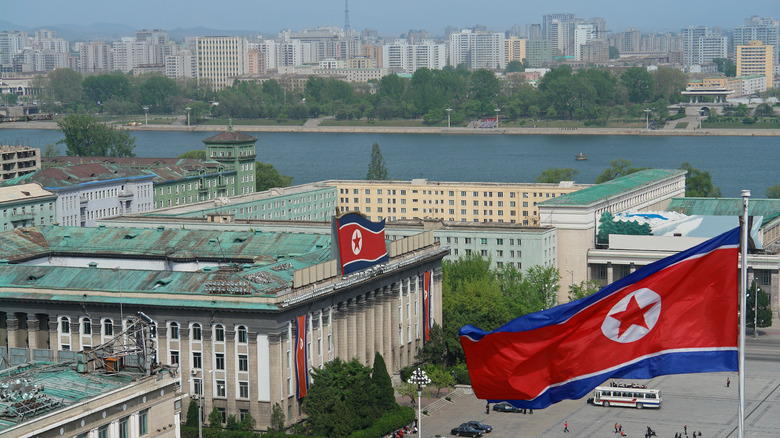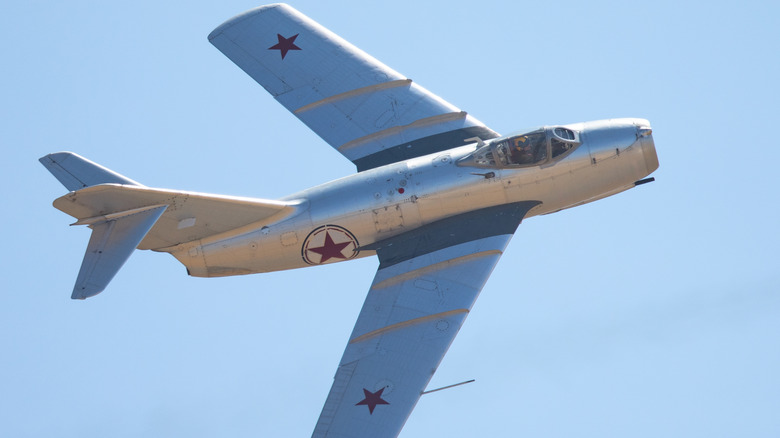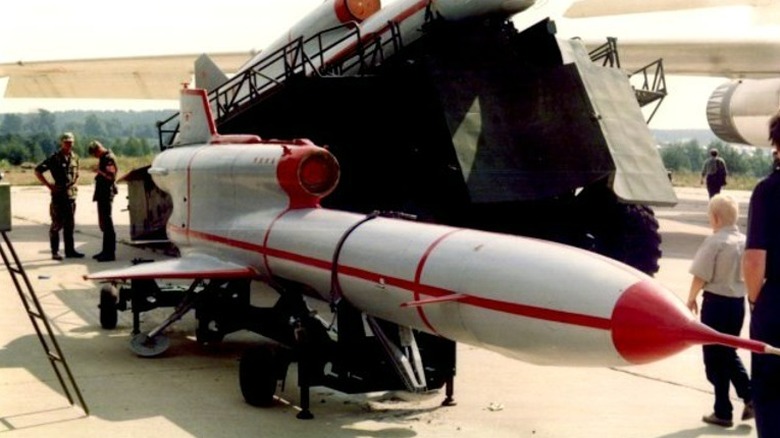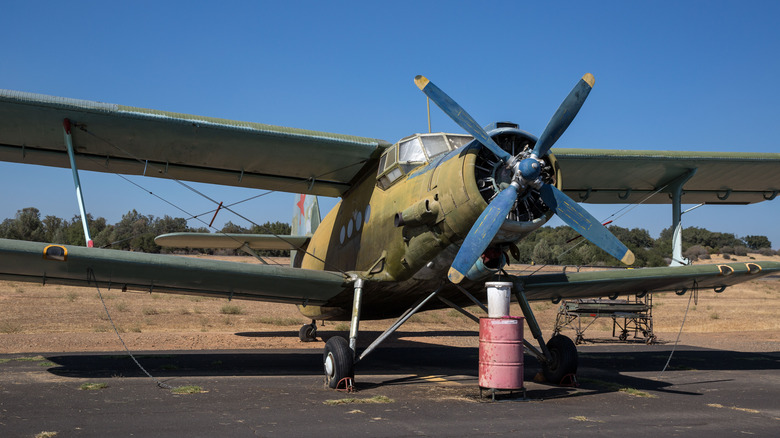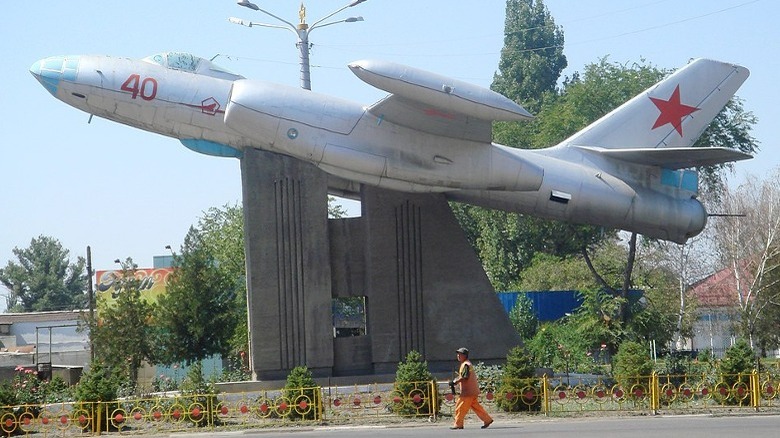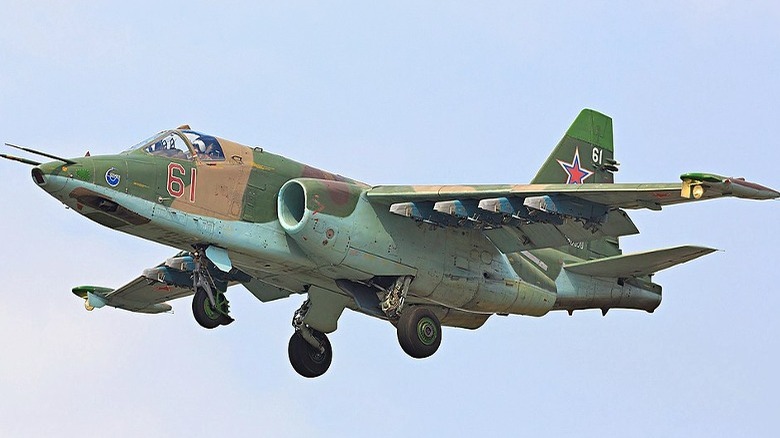5 Fighter Jets And Bombers Still Used By North Korea
North Korea is one of the most insular political spaces in the world, led by a third-generation head of state who is unpredictable at the best of times but outright hostile other times. The state's military routinely demonstrates itself through parades and missile tests, but one aspect of the North Korean capabilities remains underrepresented. The North Korean Air Force has an aerial arsenal that's both antiquated but also shows contemporary alliances as well as the effects of strict embargo and sanction measures. North Korea's air defense is a cobbled-together force of aged aircraft alongside a battery of antiaircraft and SAM installations. In fact, Pyongyang is defended by one of the most encompassing collections of defensive artillery of any capital city in the world.
North Korea isn't known for its technical air prowess, and it's reported that North Korean pilots spend just 12 to 25 hours flying every year. This is a dismal showing when compared to figures ten to fifteen times higher among American pilots. When they do fly, these are five examples of aircraft still in service among North Korea's armed forces.
An aging fleet of MiG fighters, including the MiG-15
The North Korean Air Force flies relatively newer MiG-23 and MiG-29 platforms but still relies heavily on its sizeable reserve of older MiG aircraft. In 1991, the Defense Intelligence Agency noted a fleet accounting that included 120 MiG-21s and 60 MiG-19s. since then, the strength of North Korea's air force has continued to dwindle — both as a priority firmly behind the development of nuclear capabilities. Around this time, China dialed back its material support of the country, and the Soviet Union dissolved, leaving North Korea largely on its own.
In 2021, DIA reported again on North Korean aerial capabilities bleakly. Not only does the country still rely on the same ageing aircraft 30 years later, but it's also the only one in the world to still fly MiGs that are even older (the -15 and -17 models, specifically). In 2023, it's theorized that North Korea still fields around 400 MiG-15s.
The MiG-15 was a daunting fighter jet in its heyday. Designed in 1946, a MiG-15 participated in the first all-jet dogfight in flight combat history. After the Korean War, the utility of the MiG-15 quickly fell out of step with progress, as the MiG-17 was entering production. Yet, even the most recent design in North Korea's fleet, the MiG-29, is more than 35 years old.
North Korea also operates a fleet of UAVs
North Korea routinely flies a variety of UAVs, including Chinese TranComm SKY-09 and UV10 vessels, as well as the Soviet Tu-143 Reys. All of these vessels in particular sport a range estimated below the 300-kilometer threshold that would have rendered their sale illegal under a United Nations arms embargo (specifically the Chinese models that were more recently acquired). Intelligence reporting notes that North Korea has been actively pursuing more ambitious UAV platforms. The nation likely retains a fleet of over 300 total drones (and as many as roughly 500 across nearly two dozen builds) — with some capable of carrying and deploying offensive weaponry.
UAV weapons systems on American drones can be complex and include missile and bomb components. It's known that North Korea has successfully procured American and Russian UAVs through intermediaries in the past, but the extent of its offensive capabilities isn't publicly understood.
[Featured image by Jno via Wikimedia Commons | Cropped and scaled | CC BY 2.5]
The Antonov-2 Colt
North Korea flies an estimated 200 Antonov-2 Colt propeller planes, according to Business Insider. The An-2 is yet another vintage aircraft model that has virtually left service in all other military capacities.
The An-2's primary use case in this regard is as a reconnaissance or transport vessel, and it can carry 10 passengers. The An-2 a relatively versatile option for the North Korean military, even as the platform nears its eighth full decade in existence. For most other users, this vessel, which continued to be produced, surprisingly, until 2002, is an agricultural, forestry, and geographical survey tool. However, the aircraft served as a bombing option for the North Vietnamese during the Vietnam War.
One unique feature of the Antonov-2 is its ability to essentially crawl across the sky. The vessel gives full control to the pilot at speeds as low as 30 miles per hour, and the aircraft is known to be essentially impossible to stall. These make it a great civilian aviation tool, but don't exactly translate to a whole lot of benefit in a militant scenario.
Ilyushin-28 Bomber
The Ilyushin-28 is a light bomber that first took to the skies in 1948. It entered service for the Soviet Union in 1950, with more than 6,000 units estimated to have been produced in the USSR and China, according to the Federation of American Scientists. The Il-28 flies in North Korea's Air Force these days, even as the Soviet Union retired them from service in the 1980s. Roughly 80 Il-28s make up a contingent of North Korea's bombing capacity.
The aircraft is equipped with a smattering of bombs that can total as much as 6,600 pounds of munitions. It also typically flies with a variety of cannons and machine guns in the tail section and forward compartment for self-defense while performing its duties. The Ilyushin bomber can also cover a range of nearly 1,500 miles and tops out at a speed of 544 miles per hour in optimal conditions. These features make it a potentially useful bomber for missions over the Korean Peninsula, but not much else. The Sea of Japan separates its next closes adversary by a minimum distance of 650 miles, providing ample time for Japanese forces to scramble countermeasures. Similarly, the distance ensures that the bombers themselves would be stretched to the very limits of their range.
[Featured image by Ondřej Žváček via Wikimedia Commons | Cropped and scaled | CC BY 2.5]
Sukhoi Su-25
Finally, the North Korean military utilizes the Sukhoi Su-25 in its contemporary armed services. The aircraft was first flown in 1975 and entered service for the Soviet Union in 1981. The jet offers ten loading points stacked beneath the wings for a wealth of different munitions including bombs, rockets, missiles, and machine guns.
For North Korea, these vessels played a primary role in air defense planning around Pyongyang when they initially came into service for the country during the late 1980s. This is perhaps the only jet on the list to remain a primary service vessel for other countries, as well as North Korea. Both Russia and Ukraine have deployed Su-25 jets since the Russian invasion of its neighbor, and it has become clear that in a bombing role, it has played a central role in the initial advance made by Russian forces.
The Su-25 can reach a top speed of 590 miles per hour. It is capable of carrying around 9,000 pounds of munitions.
[Featured image by Fedor Leukhin via Wikimedia Commons | Cropped and scaled | CC BY-SA 2.0]
